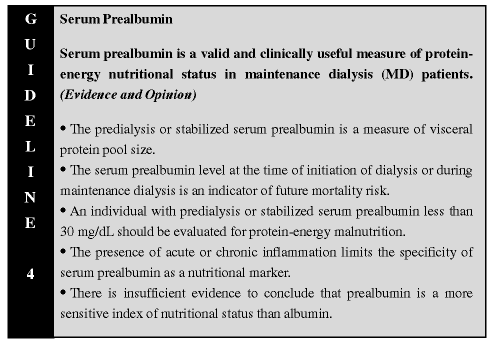
1. Evaluation of Protein-Energy Nutritional Status

Serum prealbumin (transthyretin) has been used in individuals with or without CRF as a marker of protein-energy nutritional status.40 It has been suggested that serum prealbumin may be more sensitive than albumin as an indicator of nutritional status, since it has a shorter half-life than albumin (~ 2 to 3 days versus ~ 20 days, respectively).25,41 However, prealbumin is limited by many of the same factors described for albumin. Prealbumin may not correlate with changes in other nutritional parameters31,32 and it is a negative acute-phase reactant (ie, serum levels decline in response to inflammation or infection43). In addition, recommendations for the routine use of serum prealbumin levels as a marker are tempered by the fact that prealbumin levels are increased in renal failure, presumably due to impaired degradation by the kidney.17,42 Although fewer studies have been published relating prealbumin levels to outcomes in MD patients than have been published regarding albumin levels, several studies have demonstrated that prealbumin levels less than 30 mg/dL are associated with increased mortality risk and correlate with other indices of PEM.25,41,42a,44
Based on available evidence, serum prealbumin is considered to be a valid measure of protein-energy nutritional status in individuals undergoing MD. There is insufficient evidence to conclude that prealbumin is a more sensitive or accurate index of malnutrition than is serum albumin. If the predialysis or stabilized serum prealbumin level is used to monitor nutritional status, it is recommended that the outcome goal for prealbumin is a value greater than or equal to 30 mg/dL.